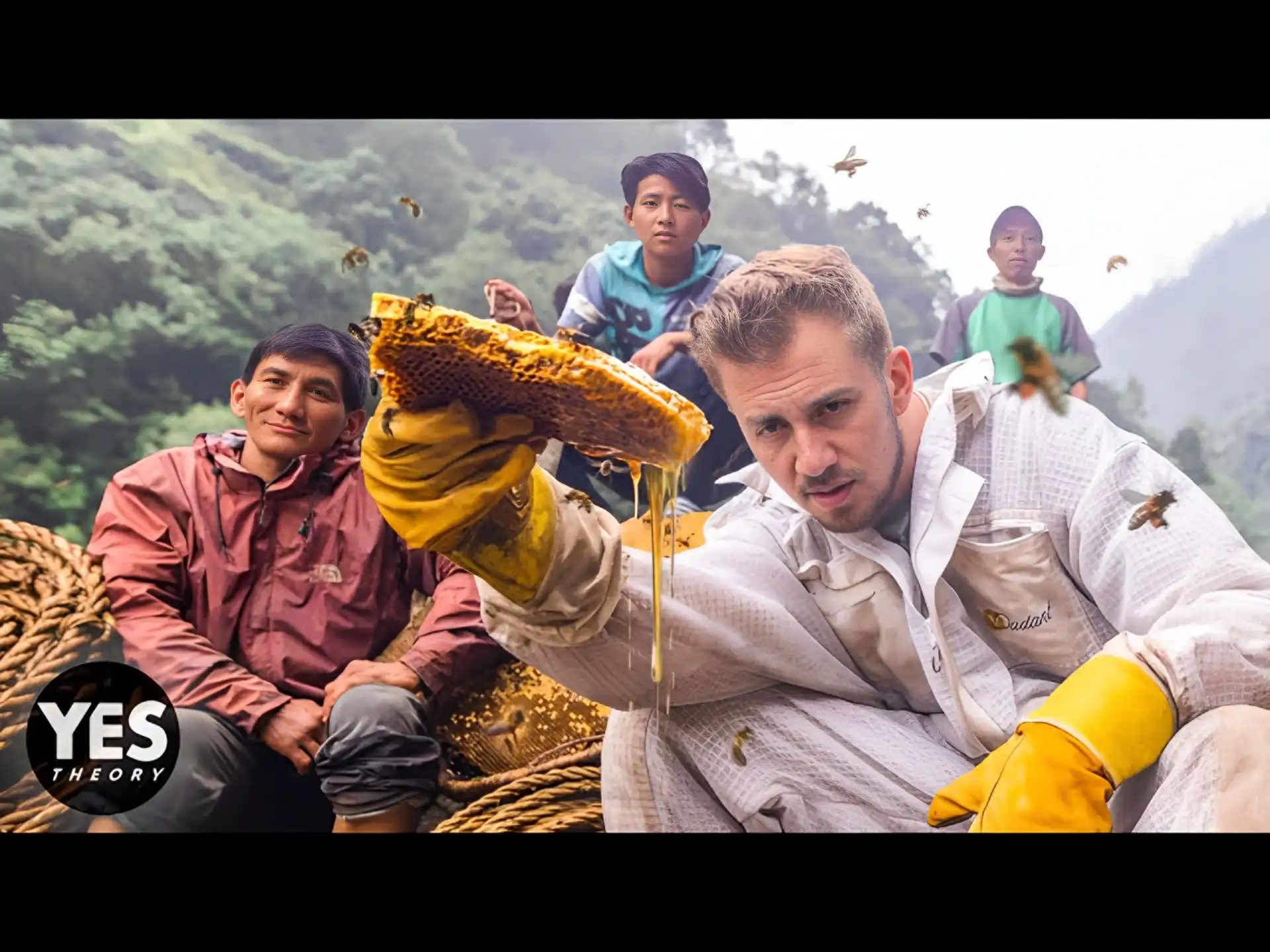The Story of Nepal’s Hallucinogenic Mad Honey!
Deep in the Himalayan foothills of Nepal, a centuries-old tradition teeters on the edge of myth and danger. This is the world of the Honey Hunters, indigenous Gurung tribesmen who brave sheer cliffs and swarms of giant bees. They seek a rare and mystical substance: mad honey.
Harvested only twice a year, this reddish, syrupy honey is not your average sweetener. Known locally as “red honey” or “mad honey”, it contains a potent neurotoxin called grayanotoxin. It induces hallucinations and a trance-like state, and, in higher doses, can cause intense nausea or even death. Despite the risks, mad honey has become a coveted delicacy and psychoactive remedy both in Nepal and abroad.
Video Credits To: https://www.youtube.com/@YesTheory
Mad honey comes from the nectar of Rhododendron flowers, abundant in the high-altitude forests of central Nepal. The largest producers are Himalayan giant bees, Apis laboriosa, which are the biggest honeybees in the world—about 3 cm long. They are adapted to the cold, rugged terrain and build enormous nests on vertical rock faces, sometimes hundreds of meters above the ground.
What makes this honey so special is the chemical cocktail found in Rhododendron nectar. The flowers contain grayanotoxins, which, when ingested, can cause a series of physiological effects—from warmth and euphoria to vertigo and hallucinations. Ancient texts from the Greeks and Romans document the use of similar honey in Turkey. There, armies reportedly weaponised it by feeding it to enemies and rendering them incapacitated.
The Honey Hunters’ Ritual
Twice a year, typically in spring (April-May) and autumn (October-November), Gurung men of central Nepal prepare for the harvest. These aren’t just simple excursions—they are spiritual missions steeped in ancestral knowledge, storytelling, and ceremony.
Before the hunt, the tribe conducts rituals to appease the forest spirits and ensure a safe journey. The lead honey hunter, often the most experienced elder, is revered as a guide and protector. Wearing minimal safety gear—sometimes only a rope, a bamboo ladder, and a head scarf—they set out to scale towering cliffs. These cliffs are where the bees have built their hives.
Reaching the hive is a feat of strength, balance, and bravery. The hunters dangle from rope ladders secured to the cliffside and battle high-altitude winds and angry bees. With a long bamboo pole, the hunter carefully dislodges pieces of the hive and collects the combs into baskets lowered to the ground. The process can take hours and often results in numerous bee stings, injuries, or worse.
The Harvest: Dangerous and Sacred
The honeycomb is divided into three parts: the outer part is regular honey, the middle holds pollen, and the deepest core contains the reddish, potent mad honey. This innermost section is the most sought-after for both its intoxicating effects and its medicinal value.
In the local culture, mad honey is believed to hold healing properties. It is used in small amounts to treat ailments like hypertension, diabetes, arthritis, and anxiety. When consumed in larger doses, it induces a dreamlike, altered state that some describe as spiritual or visionary. Because of its rarity and effect, it has also become popular among black-market buyers, collectors, and psychedelic enthusiasts around the world.
A small spoonful can bring a feeling of warmth, dizziness, and mild euphoria. Two to three spoonfuls, however, can lead to vomiting, blurred vision, and full-blown hallucinations. The line between experience and overdose is razor-thin. In extreme cases, large doses of grayanotoxins can result in cardiac arrest and death.
The Global Demand for a Psychedelic Delicacy
In recent years, mad honey has grown in popularity far beyond Nepal’s borders. It is now exported to countries like South Korea, the United States, and parts of Europe, where it is marketed as a legal psychedelic and alternative medicine. Some online sellers advertise it as a natural way to “open the third eye” or “connect with nature’s spirit.”
Due to this growing demand, the pressure on Gurung honey hunters has intensified. While the tradition has always been dangerous, the modern commercialisation of mad honey has added another layer of exploitation. Unscrupulous intermediaries sometimes buy the honey at unfair prices. There are rising concerns that overharvesting could threaten the already fragile populations of Apis laboriosa.
A Vanishing Tradition
Despite the fame and intrigue surrounding mad honey, the practice of traditional honey hunting is slowly disappearing. Fewer young Gurung men are willing to take on the risk and prefer safer, more modern livelihoods. Climate change, deforestation, and tourism have also disrupted the delicate balance of the Himalayan ecosystem. This makes the bees’ survival increasingly precarious.
Yet for those who still climb the cliffs, the honey hunt remains more than a job—it’s a sacred link to heritage, identity, and survival. Some elders worry that within a generation, the practice may vanish entirely. Efforts are being made to document and preserve the knowledge, including documentaries, ethnographic studies, and local initiatives to involve youth in sustainable harvesting practices.
Ethical and Ecological Concerns
As the demand for mad honey grows, so do the questions about its ethical sourcing. Conservationists worry about the long-term impact on bee populations and cliffside ecosystems. Without careful management, the harvesting could become unsustainable. NGOS and local cooperatives are working to establish protected harvesting zones, train younger hunters, and create fair-trade systems that benefit the Gurung people directly.
There’s also the challenge of counterfeits. As the market expanded, unscrupulous sellers began diluting or faking mad honey using regular honey colored with dyes or mixed with alcohol. This not only cheats buyers but also poses serious health risks.
A Taste of the Sacred
To the uninitiated, mad honey might seem like a novelty or a strange drug, but to the Gurung people, it is sacred. It represents a bond with nature, with ancestral spirits, and with the land. It is a reminder that some treasures cannot be harvested without risk, and that the most profound experiences often come from the edge of the world.
As interest in psychedelics and plant medicine grows around the globe, mad honey stands as a unique example of how ancient traditions and natural chemistry intersect. But it also reminds us of our responsibility to protect the cultures and ecosystems that sustain such rare wonders.













